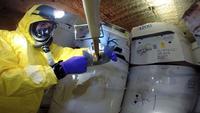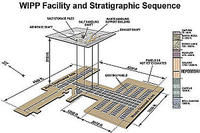-
Transparent nanoscintillators for radiation detection in homeland security, medical safety
Researchers say recently identified radiation detection properties of a light-emitting nanostructure built in their lab could open doors for homeland security and medical advances. The researchers describe a new method to fabricate transparent nanoscintillators by heating nanoparticles composed of lanthanum, yttrium and oxygen until a transparent ceramic is formed. A scintillator refers to a material that glows in response to radiation.
-
-
A second drum at nuke waste repository poses radiation leak danger

At a recent meeting of the New Mexico Legislature’s Radioactive and Hazardous Materials Committee in Carlsbad, officials were informed that a second waste drum containing nuclear materials, could also contain the same mix of ingredients as the waste drum from Los Alamos National Laboratory (LANL) which caused a radiation leak at the Waste Isolation Pilot Plant (WIPP) in February.
-
-
Deficiencies in U.S. nuclear labs’ emergency preparedness plans: Report
A recently released study of seventeen U.S. nuclear weapons laboratories by the Defense Nuclear Facilities Safety Board(DNFSB), which examined operations at the labs over the last three years, found deficiencies in emergency preparedness plans. Three New Mexico labs — the Los Alamos National Laboratory(LANL), the Waste Isolation Pilot Plant(WIPP) near Carlsbad, and Sandia National Laboratoriesin Albuquerque — exemplify various gaps in disaster preparedness throughout the nation’s nuclear defense system.
-
-
Preparing the next generation of nuclear emergency responders
The catastrophic failure of Japan’s Fukushima I Nuclear Power Plant in March 2011 was a turning point in how the scientific community viewed nuclear emergencies. Up to then, the emphasis had been on prevention, not response. Virginia Tech’s Sonja Schmid has won a 2014 National Science Foundation Faculty Early Development (CAREER) Award to study the prospects and problems of creating a global nuclear emergency response plan. Key issues to be addressed in her research are how to convince the world that any nuclear accident is everybody’s problem and how to mobilize an effective international response.
-
-
Strengthening the armor for nuclear-waste eating microbes
A microbe developed to clean up nuclear waste and patented by a Michigan State University researcher has just been improved. Researchers had identified that Geobacter bacteria’s tiny conductive hair-like appendages, or pili, did the yeoman’s share of remediation. By increasing the strength of the pili nanowires, she improved their ability to clean up uranium and other toxic wastes.
-
-
New device improves radiation detection
In a move that could have important implications for national security, researchers have created a very sensitive and tiny detector that is capable of detecting radiation from various sources at room temperature. The detector is eight to nine orders of magnitude —100 million to as high as 1 billion — times faster than the existing technology. The researchers sought to utilize the exceptional electronic carrier properties of graphene to create the photo detector device. Graphene is made of carbon atoms that are arranged in a honeycomb-like geometrical structure (the diameter of a human hair is 300,000 times thicker than a two-dimensional sheet of graphene).
-
-
No Fukushima radiation found in California’s coastal areas
Following the 11 March 2011 Fukushima disaster, researches wanted to see whether radioactivity could be found in Bay Area precipitation. They collected weeks’ worth of rainwater around UC Berkeley Campus to find out. The results: low levels of a number of different radioactive nuclei produced by the fission of uranium-235 including, cesium-134, cesium-137, and iodine-131. “The levels we saw were detectable, but low and not a health hazard to anyone,” said UC Berkeley’s nuclear engineering professor Eric Norman.
-
-
Scientists improve accuracy, reliability of nuclear tests inspection
The Comprehensive Nuclear-Test-Ban Treaty Organization (CTBTO) operates the International Monitoring System (IMS) — 279 sensors-equipped facilities around the world which detect four types of physical phenomena that can provide evidence of a nuclear explosion having taken place: seismic waves, radioactive nuclei, underwater sound waves, and infrasonic waves. The evidence from the IMS is not always enough to convince signatories of the CTBT that a nuclear test has taken place. Scientists are trying to improve the accuracy and reliability of the IMS system.
-
-
Neumedicines receives $14m for acute radiation exposure countermeasures
Neumedicines receives $14 million from BARDA to support advanced development of HemaMax, including advanced GMP manufacturing activities and a Phase 2 clinical safety study in 200 healthy human volunteers. The company says its efficacy studies have shown that a single, low-dose, subcutaneous injection of HemaMax at twenty-four hours after exposure to lethal radiation increases survival by an average of more than 2-fold without any supportive care or antibiotics.
-
-
Continued funding for S.C. mixed-oxide fuel (MOX) plant – at least until fall
Federal legislators have secured the funds to keep the mixed-oxide fuelplant (MOX) at the Savannah River Sitein South Carolina moving forward at least into fall, according to South Carolina governor Nikki Haley and members of the state’s congressional delegation. The 310-square mile site once produced components for nuclear weapons, but since the agreement with Russia to turn nuclear weapons into reactor fuel, the site has focused on repurposing and cleanup.
-
-
U.S. nuclear plant licensees should seek, act on nuclear plant hazards information
A new report concludes that the overarching lesson learned from the 2011 Fukushima Daiichi nuclear accident is that nuclear plant licensees and their regulators must actively seek out and act on new information about hazards with the potential to affect the safety of nuclear plants. The committee that wrote the report examined the causes of the Japan accident and identified findings and recommendations for improving nuclear plant safety and offsite emergency responses to nuclear plant accidents in the United States.
-
-
DOE chief to visit WIPP to discuss funding for recovery efforts

Energy Secretary Ernest Moniz will visit Carlsbad, New Mexico on 12 August to discuss funding for the Waste Isolation Pilot Plant (WIPP) recovery efforts.Traces of americium and plutonium were released from a nuclear waste drum on 14 February and were detected in the air almost a half-mile outside WIPP. On 15 May, the DOE confirmed that the damage occurred on a waste drum from Los Alamos National Laboratory.
-
-
U.K. launches inquiry into radiation poisoning of former KGB agent
British authorities have announced that a public inquiry will be held into the death of former Russian KGB officer who became a British citizen, Alexander Litvinenko.Litvinenko, 43, died in 2006 after he was poisoned with radioactive polonium while drinking tea with two former KGB agents at a London hotel.
-
-
Fire shuts down nuclear repository, but DOE still recognizes operator for “excellent” performance
Five days after an underground truck fire closed the Waste Isolation Pilot Plant (WIPP), the Energy Department (DOE) awarded Nuclear Waste Partnership (NWP), the operating contractor of the nuclear repository, $1.9 million for “excellent” performance during the past year.Shortly after the truck fire, WIPP was shut down because of radiation leak, Still, “No federal or contractor official has lost their job, been transferred, been moved off the WIPP contract or otherwise held accountable. No leadership has changed at the federal level. No company has lost a contract,” noted an industry observer.
-
-
Japan testing underground nuclear waste storage depot, despite local concerns
Data is being collected at the Horonobe Underground Research Center, in Horonobe, Japan to determine whether the site is able to begin storing radioactive waste in conditions which could last for 100,000 years.Japanese utility systems have produced more that 17,000 tons of “spent” nuclear fuel rods from power plants which are no longer useful but are expected to remain radioactive for around several thousand years.
-
More headlines
The long view
Keeping the Lights on with Nuclear Waste: Radiochemistry Transforms Nuclear Waste into Strategic Materials
How UNLV radiochemistry is pioneering the future of energy in the Southwest by salvaging strategic materials from nuclear dumps –and making it safe.
Model Predicts Long-Term Effects of Nuclear Waste on Underground Disposal Systems
The simulations matched results from an underground lab experiment in Switzerland, suggesting modeling could be used to validate the safety of nuclear disposal sites.
